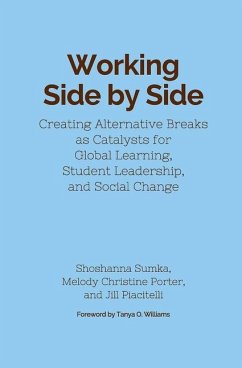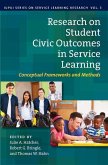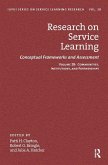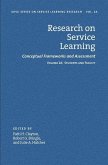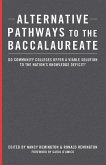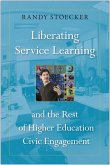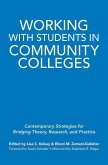Shoshanna Sumka, Melody Christine Porter, Jill Piacitelli
Working Side by Side
Creating Alternative Breaks as Catalysts for Global Learning, Student Leadership, and Social Change
Shoshanna Sumka, Melody Christine Porter, Jill Piacitelli
Working Side by Side
Creating Alternative Breaks as Catalysts for Global Learning, Student Leadership, and Social Change
- Gebundenes Buch
- Merkliste
- Auf die Merkliste
- Bewerten Bewerten
- Teilen
- Produkt teilen
- Produkterinnerung
- Produkterinnerung
Offers a guide for student and staff leaders in alternative break programmes, offering practical advice, outlining effective programme components and practices, and presenting the underlying community engagement and global learning theory. Readers will gain practical skills for implementing each of the eight components of a quality alternative break programme.
Andere Kunden interessierten sich auch für
![Research on Student Civic Outcomes in Service Learning Research on Student Civic Outcomes in Service Learning]() Research on Student Civic Outcomes in Service Learning180,99 €
Research on Student Civic Outcomes in Service Learning180,99 €![Research on Service Learning Research on Service Learning]() Research on Service Learning187,99 €
Research on Service Learning187,99 €![Research on Service Learning Research on Service Learning]() Research on Service Learning186,99 €
Research on Service Learning186,99 €![Alternative Pathways to the Baccalaureate Alternative Pathways to the Baccalaureate]() Alternative Pathways to the Baccalaureate188,99 €
Alternative Pathways to the Baccalaureate188,99 €![Liberating Service Learning and the Rest of Higher Education Civic Engagement Liberating Service Learning and the Rest of Higher Education Civic Engagement]() Randy StoeckerLiberating Service Learning and the Rest of Higher Education Civic Engagement84,99 €
Randy StoeckerLiberating Service Learning and the Rest of Higher Education Civic Engagement84,99 €![Working With Students in Community Colleges Working With Students in Community Colleges]() Working With Students in Community Colleges190,99 €
Working With Students in Community Colleges190,99 €![The Edupreneur's Side Hustle Handbook The Edupreneur's Side Hustle Handbook]() The Edupreneur's Side Hustle Handbook126,99 €
The Edupreneur's Side Hustle Handbook126,99 €-
-
-
Offers a guide for student and staff leaders in alternative break programmes, offering practical advice, outlining effective programme components and practices, and presenting the underlying community engagement and global learning theory. Readers will gain practical skills for implementing each of the eight components of a quality alternative break programme.
Hinweis: Dieser Artikel kann nur an eine deutsche Lieferadresse ausgeliefert werden.
Hinweis: Dieser Artikel kann nur an eine deutsche Lieferadresse ausgeliefert werden.
Produktdetails
- Produktdetails
- Verlag: Taylor & Francis
- Seitenzahl: 390
- Erscheinungstermin: 2. Juli 2015
- Englisch
- Abmessung: 229mm x 150mm x 33mm
- Gewicht: 680g
- ISBN-13: 9781620361238
- ISBN-10: 162036123X
- Artikelnr.: 41964940
- Herstellerkennzeichnung
- Libri GmbH
- Europaallee 1
- 36244 Bad Hersfeld
- gpsr@libri.de
- Verlag: Taylor & Francis
- Seitenzahl: 390
- Erscheinungstermin: 2. Juli 2015
- Englisch
- Abmessung: 229mm x 150mm x 33mm
- Gewicht: 680g
- ISBN-13: 9781620361238
- ISBN-10: 162036123X
- Artikelnr.: 41964940
- Herstellerkennzeichnung
- Libri GmbH
- Europaallee 1
- 36244 Bad Hersfeld
- gpsr@libri.de
Shoshanna Sumka is the Assistant Director of Global Learning and Leadership at American University, where she oversees the alternative break program and other international immersion programs. At AU, she developed the program from the ground up, created a leadership training curriculum, and increased participation by 300%. As a leader in international & experiential education, she has lived, worked and/or traveled extensively in Kenya, Israel, Indonesia, Venezuela, Zambia, Thailand, Colombia, Haiti, and India. She directed the University of Idaho's study abroad program in Ecuador where she taught courses on indigenous rights in the Amazon rain forest. She has a BA in Sociology and Anthropology from Earlham College and a Master's in Applied Anthropology from the University of Maryland. Shoshanna was named Break Away Staff Person of the Year in 2012. Melody Christine Porter is the Associate Director of Community Engagement at the College of William and Mary, where she supervises the alternative breaks program and develops community partnerships. Previously, she served as Director of Volunteer Emory at Emory University, where she developed an alternative fall break program. She has worked in nonprofit administration, ministry, and served as a full-time volunteer for three years after college, in Philadelphia, PA and Johannesburg, South Africa. Melody holds a Master's in Divinity from the Candler School of Theology at Emory University and a BA in Political Science from Emory University. Melody was named Staff Person of the Year by Break Away in 2010, and her program at William and Mary received the Program of the Year award in 2011. Jill Piacitelli is the co-Executive Director at Break Away, having led the organization since 2004. Jill has worked with alternative break programs in various capacities for over fifteen years: in various positions with Break Away: The Alternative Break Connection, as a staff advisor while working on the campuses of Johnson St
Figures and Tables Foreword Acknowledgments Introduction PART ONE.
FOUNDATIONS 1. Alternative Breaks Defined 2. A Brief History of Alternative
Breaks. The Beginnings of the Movement 3. Working Together for Justice. A
Theoretical Framework 4. Developing Community Partnerships for Mutual
Benefit 5. Alternative Breaks as Catalysts of Active Citizenship PART TWO.
KEY COMPONENTS OF ALTERNATIVE BREAKS 6. The Eight Components. Foundations
of a Successful Alternative Break Program 7. Diversity and Social Justice.
Addressing Power, Privilege, and Systems of Oppression 8. Education.
Understanding Social Issues 9. Orientation. Learning About the
Organization, Location, and Context 10. Training. Building Skills 11.
Strong Direct Service. Working With Communities 12. Alcohol- and Drug-Free
Programs. Practicing Full Engagement 13. Reflection. Synthesizing Learning
and Experience 14. Reorientation. Active Citizens Reorganizing Locally PART
THREE. STUDENT LEADERSHIP, LEARNING, AND TRANSFORMATION 15. Student
Leadership in Action 16. Program Structures and Leadership Roles 17.
Training Student Leaders 18. Assessing Student Learning PART FOUR.
DEVELOPING AND STRENGTHENING ALTERNATIVE BREAK PROGRAMS 19. Program Growth
and Continual Improvement 20. Community Building 21. Recruiting Leaders and
Participants 22. Budgeting, Finances, and Fund-raising 23. Risk Management
and Other Logistics PART FIVE. GOING GLOBAL 24. The Complexities of
International Alternative Breaks 25. Developing International Community
Partnerships 26. Working with Intermediary Organizations PART SIX. A
SOCIETY OF ACTIVE CITIZENS 27. Working Collaboratively Through Compacts and
Collectives 28. The Power of Alternative Break Alumni Epilogue. A Call to
Action References Index
FOUNDATIONS 1. Alternative Breaks Defined 2. A Brief History of Alternative
Breaks. The Beginnings of the Movement 3. Working Together for Justice. A
Theoretical Framework 4. Developing Community Partnerships for Mutual
Benefit 5. Alternative Breaks as Catalysts of Active Citizenship PART TWO.
KEY COMPONENTS OF ALTERNATIVE BREAKS 6. The Eight Components. Foundations
of a Successful Alternative Break Program 7. Diversity and Social Justice.
Addressing Power, Privilege, and Systems of Oppression 8. Education.
Understanding Social Issues 9. Orientation. Learning About the
Organization, Location, and Context 10. Training. Building Skills 11.
Strong Direct Service. Working With Communities 12. Alcohol- and Drug-Free
Programs. Practicing Full Engagement 13. Reflection. Synthesizing Learning
and Experience 14. Reorientation. Active Citizens Reorganizing Locally PART
THREE. STUDENT LEADERSHIP, LEARNING, AND TRANSFORMATION 15. Student
Leadership in Action 16. Program Structures and Leadership Roles 17.
Training Student Leaders 18. Assessing Student Learning PART FOUR.
DEVELOPING AND STRENGTHENING ALTERNATIVE BREAK PROGRAMS 19. Program Growth
and Continual Improvement 20. Community Building 21. Recruiting Leaders and
Participants 22. Budgeting, Finances, and Fund-raising 23. Risk Management
and Other Logistics PART FIVE. GOING GLOBAL 24. The Complexities of
International Alternative Breaks 25. Developing International Community
Partnerships 26. Working with Intermediary Organizations PART SIX. A
SOCIETY OF ACTIVE CITIZENS 27. Working Collaboratively Through Compacts and
Collectives 28. The Power of Alternative Break Alumni Epilogue. A Call to
Action References Index
Figures and Tables Foreword Acknowledgments Introduction PART ONE.
FOUNDATIONS 1. Alternative Breaks Defined 2. A Brief History of Alternative
Breaks. The Beginnings of the Movement 3. Working Together for Justice. A
Theoretical Framework 4. Developing Community Partnerships for Mutual
Benefit 5. Alternative Breaks as Catalysts of Active Citizenship PART TWO.
KEY COMPONENTS OF ALTERNATIVE BREAKS 6. The Eight Components. Foundations
of a Successful Alternative Break Program 7. Diversity and Social Justice.
Addressing Power, Privilege, and Systems of Oppression 8. Education.
Understanding Social Issues 9. Orientation. Learning About the
Organization, Location, and Context 10. Training. Building Skills 11.
Strong Direct Service. Working With Communities 12. Alcohol- and Drug-Free
Programs. Practicing Full Engagement 13. Reflection. Synthesizing Learning
and Experience 14. Reorientation. Active Citizens Reorganizing Locally PART
THREE. STUDENT LEADERSHIP, LEARNING, AND TRANSFORMATION 15. Student
Leadership in Action 16. Program Structures and Leadership Roles 17.
Training Student Leaders 18. Assessing Student Learning PART FOUR.
DEVELOPING AND STRENGTHENING ALTERNATIVE BREAK PROGRAMS 19. Program Growth
and Continual Improvement 20. Community Building 21. Recruiting Leaders and
Participants 22. Budgeting, Finances, and Fund-raising 23. Risk Management
and Other Logistics PART FIVE. GOING GLOBAL 24. The Complexities of
International Alternative Breaks 25. Developing International Community
Partnerships 26. Working with Intermediary Organizations PART SIX. A
SOCIETY OF ACTIVE CITIZENS 27. Working Collaboratively Through Compacts and
Collectives 28. The Power of Alternative Break Alumni Epilogue. A Call to
Action References Index
FOUNDATIONS 1. Alternative Breaks Defined 2. A Brief History of Alternative
Breaks. The Beginnings of the Movement 3. Working Together for Justice. A
Theoretical Framework 4. Developing Community Partnerships for Mutual
Benefit 5. Alternative Breaks as Catalysts of Active Citizenship PART TWO.
KEY COMPONENTS OF ALTERNATIVE BREAKS 6. The Eight Components. Foundations
of a Successful Alternative Break Program 7. Diversity and Social Justice.
Addressing Power, Privilege, and Systems of Oppression 8. Education.
Understanding Social Issues 9. Orientation. Learning About the
Organization, Location, and Context 10. Training. Building Skills 11.
Strong Direct Service. Working With Communities 12. Alcohol- and Drug-Free
Programs. Practicing Full Engagement 13. Reflection. Synthesizing Learning
and Experience 14. Reorientation. Active Citizens Reorganizing Locally PART
THREE. STUDENT LEADERSHIP, LEARNING, AND TRANSFORMATION 15. Student
Leadership in Action 16. Program Structures and Leadership Roles 17.
Training Student Leaders 18. Assessing Student Learning PART FOUR.
DEVELOPING AND STRENGTHENING ALTERNATIVE BREAK PROGRAMS 19. Program Growth
and Continual Improvement 20. Community Building 21. Recruiting Leaders and
Participants 22. Budgeting, Finances, and Fund-raising 23. Risk Management
and Other Logistics PART FIVE. GOING GLOBAL 24. The Complexities of
International Alternative Breaks 25. Developing International Community
Partnerships 26. Working with Intermediary Organizations PART SIX. A
SOCIETY OF ACTIVE CITIZENS 27. Working Collaboratively Through Compacts and
Collectives 28. The Power of Alternative Break Alumni Epilogue. A Call to
Action References Index

